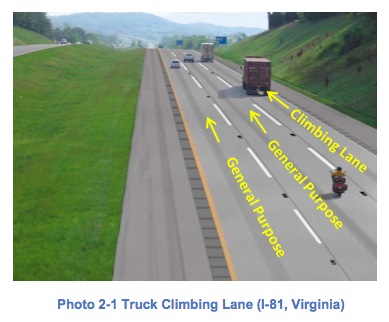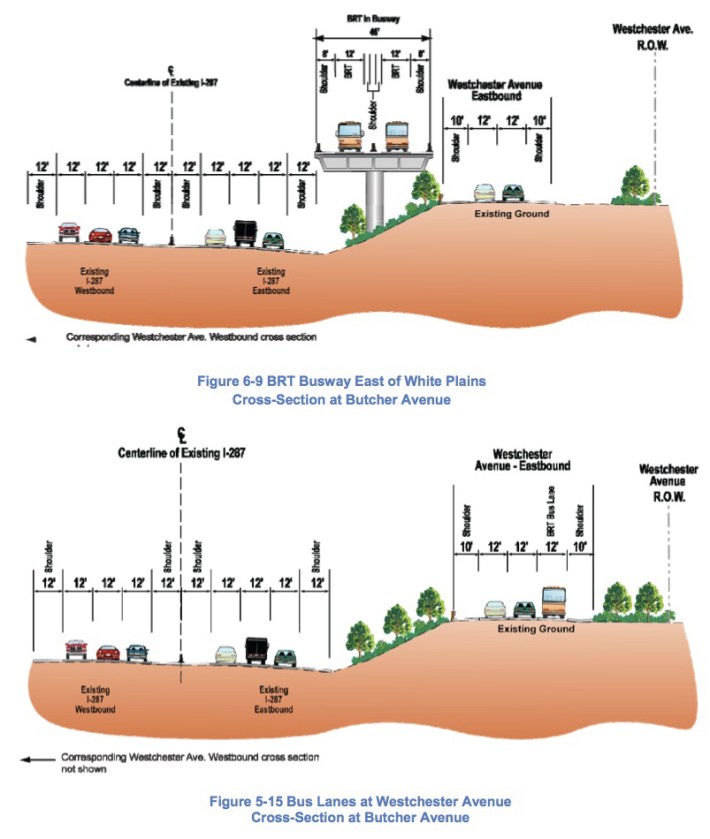
At the beginning of the week, Governor Andrew Cuomo launched a media offensive to defend his decision to halt all work on building new transit infrastructure across the Tappan Zee Bridge. "The bus system would roughly double the cost of the bridge," Cuomo told radio host Fred Dicker.
But according to recently released state documents reviewed by Streetsblog, Cuomo's claim is false. Even a gold-plated bus rapid transit system from Suffern to Port Chester would not cost the $5 billion that Cuomo says it would. The $5 billion figure includes between $1 billion and $3 billion worth of highway improvements, many of which are entirely unrelated to building transit.
The newly available documents, which date from late 2010 and early 2011, were first obtained by the Tri-State Transportation Campaign under the state's Freedom of Information Law. Only after Tri-State received the documents did the Cuomo administration post them on its Tappan Zee Bridge website.
The Cuomo administration states that building a full BRT corridor would cost between $4.5 billion and $5.3 billion, depending on the design selected. "The $5 billion we estimate simply accounts for the costs of adding new dedicated lanes to the highways on each side of the bridge, and that doesn’t even include an extra $80 million in operating cost for running the stations and the buses," said Cuomo spokesperson Matt Wing.

But a document from May 2011, before the Cuomo administration canceled the transit components of the Tappan Zee project, makes clear that those totals include enormous sums dedicated to highway improvements along I-287, not transit [PDF]. Between $1.04 billion and $3.14 billion of those estimates, the document says, are for highway improvements.
The Cuomo administration has justified including billions of dollars in highway spending in its BRT cost estimates by arguing that they are necessary to build the bus system. The new state documents reviewed by Streetsblog show that this, too, is false.
Exactly what those billions of dollars of highway improvements include is difficult to ascertain. In earlier versions of the Tappan Zee project, the state simultaneously pursued a bus rapid transit system, I-287 expansions, and a new commuter rail service into Rockland County. All of those costs are tied up together in planning documents from the time.
But some of the costs for each component can be disentangled, and it is clear that not all the highway spending is necessary for high-quality bus service.
A "Highway Improvement Report" produced in November 2010 lays out some of the I-287 spending [PDF]. The Cuomo administration's Tappan Zee website claims that this report "explains the additional requirements necessary due to the transit systems," and Wing confirmed that the report's recommendations were included in the administration's estimates of BRT costs.
The first item in the report, however, has nothing to do with transit. The Highway Improvement Report suggests constructing climbing lanes in Rockland County to allow passenger vehicles to pass slow-moving trucks on uphill stretches. Bus service, which would run in its own dedicated lanes, would not be affected by the climbing lanes. The cost of these extra lanes alone was estimated at $446 million.
Doubling the width of ramps at Exit 13 would have cost another $55 million. Again, the Highway Improvement Report does not justify the construction of the lanes in terms of transit operation.
Between just those two projects, the state has tacked on half a billion dollars in non-transit costs to the price tag of BRT.
There are other, harder to quantify, highway costs included as well, like the state's plan to reconstruct or repave the entire highway corridor. “If the state's BRT cost analysis only considered installing bus rapid transit in the context of a massive I-287 overhaul, it made a mistake," said Veronica Vanterpool, executive director of Tri-State Transportation Campaign, in a statement. "You don’t need to dig a tunnel to paint a bus lane.”
Just how overinflated is Cuomo's pricing? It's hard to pin down a precise number, but here's a look at how the administration is overlooking the most cost-effective options available.

Last year, the state estimated that the entire Westchester side of the BRT system could be built for a little more than $1 billion, including soft costs like engineering and potential cost overruns [PDF]. That option would run mainly along existing roads like Rt. 119 or Westchester Avenue, with slight road widenings in some locations to add dedicated bus lanes. The plan also calls for viaducts in a few locations. (The state also studied a pricier option for the Westchester side of the bridge [PDF], in which buses would run entirely on a brand-new viaduct, up to 40 feet above the highway.)
So half of the entire BRT corridor could be built for just above $1 billion, if the Cuomo administration decided to pursue the surface option. "Westchester County and the local communities strongly opposed this option," said Wing. He added that local officials had feared additional congestion from the cheaper, on-street option in years past, but did not provide documentation that the more affordable option would actually have negative effects on traffic.
Because the state had planned to build new high-occupancy vehicle lanes in Rockland County, it did not study an on-street BRT option west of the Tappan Zee Bridge. Such a solution might exist, or buses could run in the existing shoulders of I-287, a common practice around the country.
In either case, there clearly are lower-cost transit options that the state could pursue. The actual price of building bus rapid transit, even a full-featured system running along the whole corridor, is possibly billions of dollars less than Cuomo claims.
"Regions and states that build and develop and advance will flourish and those that don’t have the capacity will decline," Cuomo told Dicker, arguing for building the bridge now, without transit. "The question is, can you overcome the opposition, the controversy, and actually get a project done?"
When it comes to transit, the governor would do well to heed his own words -- can he actually get a forward-thinking transportation project done? Andrew Cuomo needs to start providing an honest and transparent accounting of what it would really take to build a Tappan Zee Bridge bus rapid transit system, and his administration needs to get back to work and finish a plan to build cost-effective transit. New York cannot give up on transit because of the governor's opposition and a false $5 billion price tag.





